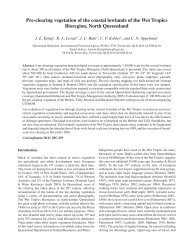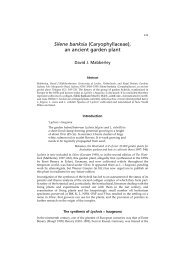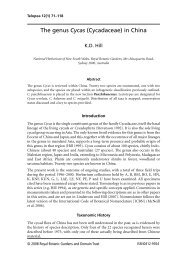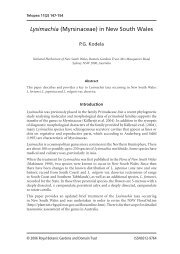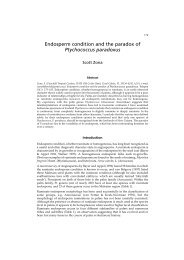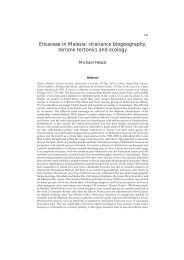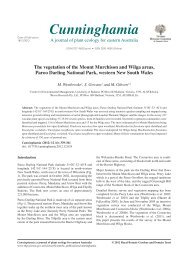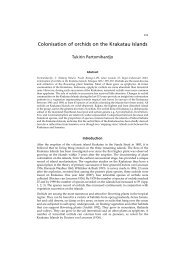Bryophytes and their distribution in the Blue Mountains region of ...
Bryophytes and their distribution in the Blue Mountains region of ...
Bryophytes and their distribution in the Blue Mountains region of ...
You also want an ePaper? Increase the reach of your titles
YUMPU automatically turns print PDFs into web optimized ePapers that Google loves.
Cunn<strong>in</strong>ghamia 10(2): 2007 Down<strong>in</strong>g et al, <strong>Bryophytes</strong> <strong>in</strong> <strong>the</strong> <strong>Blue</strong> Mounta<strong>in</strong>s 249<br />
liverworts Plagiochasma rupestre, Reboulia hemisphaerica<br />
<strong>and</strong> *Lunularia cruciata. Three hornworts, Anthoceros<br />
punctatus, Megaceros gracilis <strong>and</strong> Phaeoceros cf.<br />
carol<strong>in</strong>ianus have also been recorded at Colong.<br />
In addition to naturally-occurr<strong>in</strong>g limestone areas, many<br />
walls, arches <strong>and</strong> shelter sheds <strong>in</strong> <strong>the</strong> <strong>Blue</strong> Mounta<strong>in</strong>s<br />
have been built from s<strong>and</strong>stone <strong>and</strong> cemented with lime<br />
mortar, a perfect substrate for calciphiles. At Blackheath,<br />
Bryoerythrophyllum b<strong>in</strong>nsii (Pottiaceae) grows on<br />
compacted soil near low concrete dra<strong>in</strong>s along <strong>the</strong> path<br />
through natural bushl<strong>and</strong> to Govetts Leap. Similarly, Alo<strong>in</strong>a<br />
aloides var. ambigua (Pottiaceae) grows on mortar <strong>of</strong> an<br />
old stone fire place <strong>in</strong> Megalong Valley, on <strong>the</strong> sou<strong>the</strong>rn<br />
side <strong>of</strong> Blackheath. At Mount York Lookout <strong>and</strong> Mitchells<br />
Lookout, west <strong>of</strong> Mount Victoria, <strong>and</strong> at <strong>the</strong> Three Sisters at<br />
Katoomba, stone walls <strong>in</strong> park<strong>in</strong>g areas have an abundance<br />
<strong>of</strong> mosses from <strong>the</strong> Pottiaceae, <strong>in</strong>clud<strong>in</strong>g Barbula cr<strong>in</strong>ita,<br />
Tortula muralis, Tortula antarctica, Triquetrella papillata<br />
<strong>and</strong> Weissia controversa. Grimmia pulv<strong>in</strong>ata is also common<br />
<strong>and</strong> abundant on <strong>the</strong>se walls. Compacted soil close to <strong>the</strong>se<br />
structures supports populations <strong>of</strong> Bryaceae, <strong>in</strong>clud<strong>in</strong>g Bryum<br />
argenteum, Bryum lanatum, Gemmabryum dichotomum,<br />
Gemmabryum pachy<strong>the</strong>ca <strong>and</strong> Rosulabryum torquescens.<br />
Pseudoleskeopsis imbricata is occasionally found on mortar<br />
or cement.<br />
Urban development <strong>in</strong> <strong>the</strong> <strong>Blue</strong> Mounta<strong>in</strong>s– cosmopolitan<br />
<strong>and</strong> <strong>in</strong>troduced species<br />
Urban development <strong>in</strong> <strong>the</strong> <strong>Blue</strong> Mounta<strong>in</strong>s rapidly followed<br />
<strong>the</strong> construction <strong>of</strong> <strong>the</strong> railway <strong>in</strong> 1869. The new towns<br />
extensively changed <strong>the</strong> local environment. Non-native<br />
species <strong>of</strong> bryophytes have been <strong>in</strong>troduced <strong>and</strong> some native<br />
species have become particularly abundant.<br />
The small but very conspicuous silver cosmopolitan moss<br />
cBryum argenteum <strong>and</strong> <strong>the</strong> thallose liverwort *Lunularia<br />
cruciata thrive <strong>in</strong> areas <strong>of</strong> high nitrogen, which may<br />
orig<strong>in</strong>ate from garden fertilizer, animal faeces or sewage.<br />
cBryum argenteum also grows <strong>in</strong> dense cushions <strong>in</strong> crevices<br />
<strong>in</strong> bitumen or concrete paths. cBryum argenteum <strong>and</strong><br />
Gemmabryum dichotomum were collected from dumped<br />
concrete rubble at Mount Banks.<br />
c The mosses Funaria hygrometrica, Gemmabryum<br />
dichotomum, Racopilum cuspidigerum var. convolutaceum<br />
<strong>and</strong> Rosulabryum billarderi toge<strong>the</strong>r with liverworts<br />
Marchantia berteroana <strong>and</strong> *Marchantia polymorpha var.<br />
aquatica are common glasshouse ‘weeds’ <strong>and</strong> are <strong>of</strong>ten<br />
transplanted <strong>in</strong>to gardens with <strong><strong>the</strong>ir</strong> accompany<strong>in</strong>g plants.<br />
Yellowish-orange wefts <strong>of</strong> <strong>the</strong> moss Thuidiopsis sparsa are<br />
common on concrete gutters <strong>and</strong> dra<strong>in</strong>s. Barbula calyc<strong>in</strong>a <strong>and</strong><br />
cWeissia controversa, both native species, thrive <strong>in</strong> compacted<br />
roadside soil.<br />
Fig. 9. Alp<strong>in</strong>e bryophytes <strong>in</strong>clud<strong>in</strong>g Andreaea subulata, Andreaea mutabilis, Bl<strong>in</strong>dia robusta <strong>and</strong> Polytrichastrum formosum are part <strong>of</strong> <strong>the</strong><br />
vegetation near Darw<strong>in</strong>s Walk, along Jamison Creek from nearby Wentworth Falls Railway Station to <strong>the</strong> top <strong>of</strong> Wentworth Falls, shown<br />
here.





